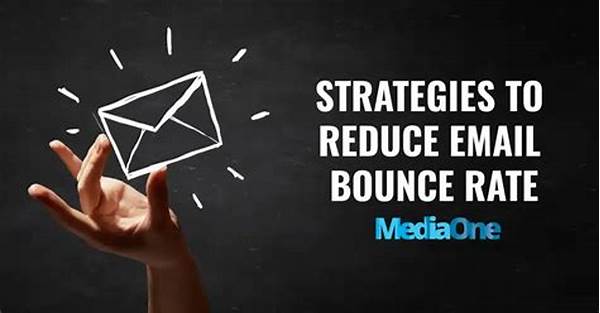The phenomenon of email bounces presents significant challenges to businesses, marketers, and organizations striving to maintain effective communication with their audiences. An email bounce occurs when an email fails to deliver to its intended recipient, which can be due to various reasons ranging from non-existent email addresses to full inboxes. The repercussions of email bounces include diminished delivery rates, a tarnished sender reputation, and ultimately, ineffective marketing campaigns. Implementing strategies for reducing email bounces is paramount in ensuring optimal email deliverability and maintaining strong contact with your audience.
Read Now : Integrated Innovation-driven Development
Understanding Email Bounces and Their Impact
Email bounces can be broadly categorized into “hard” and “soft” bounces. Hard bounces occur when an email reaches an invalid or non-existent address, often as a result of typos or outdated contact lists. Conversely, soft bounces are temporary issues where delivery is impeded by factors such as a full recipient inbox or a temporary server problem. Both impact the overall effectiveness of email campaigns. Businesses must prioritize strategies for reducing email bounces by regularly updating and verifying their email lists, engaging in data hygiene practices, and ensuring their content adheres to email service standards.
Implementing robust strategies for reducing email bounces can lead to enhanced communication efficiency and a better return on investment in email marketing efforts. Cleaning email lists, using double opt-in subscriptions, and monitoring email deliverability rates are all pivotal steps. These strategies aim at minimizing hard bounces, while proper email management systems address soft bounces by automatically retrying to send emails. Ultimately, understanding the causes and types of bounces empowers businesses to tailor their strategies for reducing email bounces, thereby fortifying their electronic communication frameworks.
Key Strategies for Reducing Email Bounces
1. Maintaining an Updated Email List: Ensuring your email list is current helps in reducing hard bounces. Regular audits and updates remove inactive or incorrect addresses, making this a crucial strategy for reducing email bounces.
2. Implementing Double Opt-In: A double opt-in mechanism for subscribers ensures that only valid and interested users join your list. This technique effectively contributes to strategies for reducing email bounces by confirming their email validity.
3. Engaging in Data Hygiene Practices: Regular list cleaning and data validation practices are essential strategies for reducing email bounces. These involve removing invalid emails and correcting typographical errors to ensure lists remain pristine.
4. Monitoring and Validating Email Deliverability: Keeping track of bounce rates and addressing the underlying issues ensures continued email delivery success. This form of monitoring is a vital part of strategies for reducing email bounces.
5. Using Professional Email Services: Collaborating with reputable email service providers can drastically improve deliverability rates. Their built-in tools and algorithms are geared towards strategies for reducing email bounces effectively.
Best Practices for Email Verification
Email verification stands out as an essential component in the strategies for reducing email bounces. By employing verification processes, businesses can ensure that their email list contains only valid and active addresses. Advanced software tools and third-party services provide real-time verification, identifying and eliminating invalid emails before distribution. This not only reduces bounce rates but also ensures that business communications reach the intended audience efficiently, thereby enhancing engagement rates.
Moreover, integrating email verification into routine operations streamlines the overall campaign effectiveness. Regular validation checks are imperative in guaranteeing the accuracy and reliability of contact lists. Ensuring data quality remains uncompromised is a critical aspect of strategies for reducing email bounces. Email verification should be seen as an ongoing effort rather than a one-time implementation, constantly safeguarding the integrity of communication channels.
Read Now : Driving Growth Through Sector Partnerships
Implementing Advanced Filtering and Segmentation Techniques
Effective segmentation is one of the indispensable strategies for reducing email bounces. When executed properly, it ensures that messages are relevant, targeted, and engaging, thereby reducing the likelihood of recipient disinterest and subsequent bounces. Advanced filtering allows businesses to group their audience based on distinct criteria such as engagement history, purchase behavior, and demographic data.
Employing segmentation and filtering also assists marketers in crafting personalized content that resonates with individual recipients. Strategically implemented, these strategies for reducing email bounces lead to higher engagement and conversion rates. It is essential for marketers to routinely analyze and adapt their segmentation strategies in response to evolving customer dynamics, ensuring that messaging remains pertinent and effective in minimizing bounces.
The Role of Authentication Protocols in Minimizing Bounces
Authentication protocols such as SPF, DKIM, and DMARC serve as instrumental strategies for reducing email bounces. These protocols validate email sources, assuring recipients and internet service providers of the authenticity of inbound emails. Deploying such measures aids in preventing unauthorized entities from exploiting legitimate email IDs, a common cause of hard bounces. Therefore, businesses committed to minimizing bounces must ensure their authentication protocols are up-to-date and effectively configured.
Furthermore, these protocols enhance security by building trust with email platforms, thereby promoting higher delivery rates. Authentication is not merely a defensive measure but a comprehensive strategy that aligns with broader initiatives aimed at reducing email bounces, safeguarding brand reputation, and sustaining healthy recipient relationships.
Conclusion: Ensuring Continuous Improvement in Email Deliverability
In conclusion, establishing successful strategies for reducing email bounces necessitates continuous vigilance and adaptive measures. Maintaining an updated and verified email list forms the cornerstone of these strategies, while employing cutting-edge technologies and adopting industry best practices ensure robust outcomes. Equally important is the implementation of sophisticated filtering, segmentation, and authentication protocols aimed at minimizing both hard and soft bounces.
Regular monitoring and analysis provide insights into evolving trends and potential areas for enhancement. Thoroughly understanding and addressing the root causes of bounces facilitates sustained improvement in email deliverability. For businesses aiming to refine their communication processes, integrating these strategies for reducing email bounces becomes an essential undertaking. By doing so, organizations bolster their engagement metrics, safeguard their sender reputations, and ultimately achieve more successful interaction with their target audiences.
